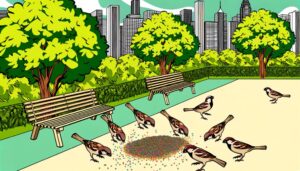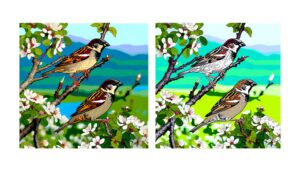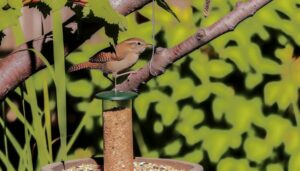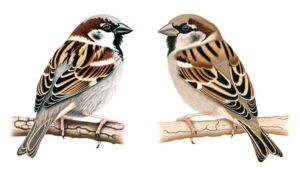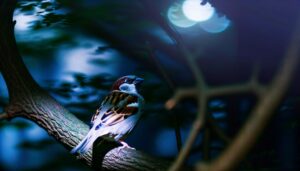Dead Sparrow Indoors: Unravel Its Meaning in Your House
A dead sparrow in a house is imbued with symbolism and cultural beliefs, often signifying transformation, the end of a life phase, or potential misfortune. Historical interpretations link sparrows to the soul and the afterlife, reflecting profound spiritual meanings.
Psychological responses include distress and reflective thought about loss or change. From an environmental perspective, sparrows may enter homes seeking food or shelter, emphasizing the importance of secure windows and adequate sanitation.
Cleaning up a dead sparrow requires precautions due to health risks posed by pathogens. More detailed observations reveal additional layers of interpretation and preventive measures.
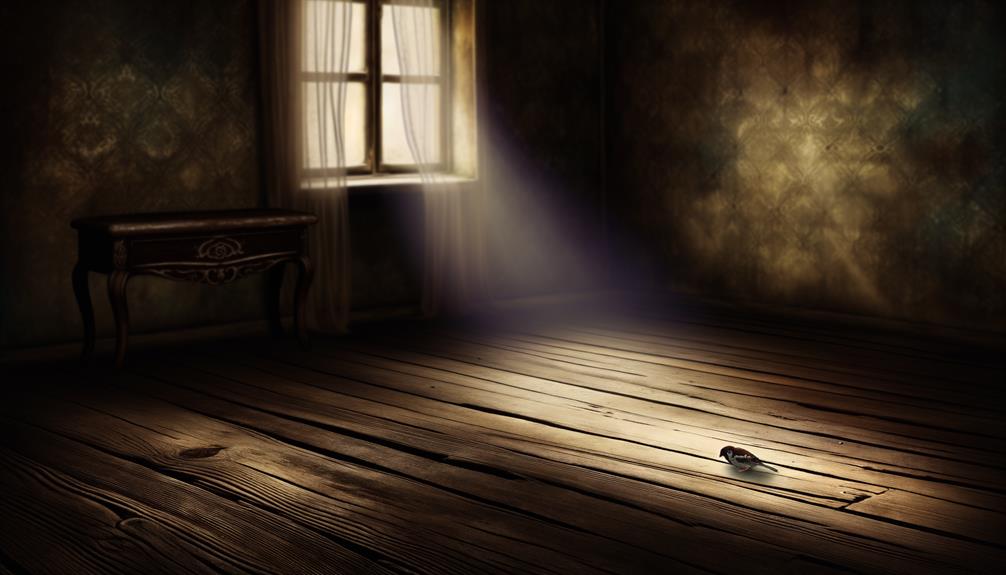
Key Takeaways
- Dead sparrows in homes symbolize transformation, the end of a life phase, or impending change.
- Various cultures view dead sparrows as signs of misfortune or upcoming challenges.
- Sparrows are seen as messengers or symbols of the soul in spiritual traditions.
- Psychological reactions to finding a dead sparrow may include distress and reflective thoughts about loss.
- Dead sparrows indoors pose health risks from pathogens, requiring prompt and safe disposal.
Cultural Symbolism
Various cultures throughout history have ascribed specific symbolic meanings to sparrows, often interpreting their presence or demise within a household through the lenses of folklore, mythology, and spiritual beliefs.
In numerous societies, the sparrow has been emblematic of various human attributes, including love, loyalty, and industriousness. Detailed observations indicate that in ancient Egypt, sparrows were believed to carry the souls of the deceased to the afterlife.
Similarly, in some Native American traditions, sparrows were seen as symbols of joy and protection. Evidence-based research into literary sources reveals that these birds often appear in texts as metaphors for freedom and resilience.
Such symbolic interpretations vary widely, reflecting the diverse cultural contexts in which sparrows are revered or regarded with superstition.
Historical Beliefs
Building upon the cultural symbolism of sparrows, historical beliefs about these birds often intertwine with early religious practices, superstitions, and ancient societal norms.
In ancient Egypt, sparrows were thought to carry the souls of the deceased to the afterlife, while in Greek mythology, they were associated with Aphrodite, symbolizing love and renewal.
Medieval European folklore often depicted sparrows as omens of death or bad luck, particularly when found dead within homes. These associations are documented in various historical texts and art, reflecting the pervasive influence of sparrows across different civilizations.
The integration of sparrows into religious rites and societal beliefs underscores their longstanding symbolic significance, providing a rich tapestry of historical context for understanding their presence in human environments.
Spiritual Interpretations
In contemporary spiritual contexts, the presence of a dead sparrow in one's home is often interpreted as a significant symbol, potentially heralding a period of transformation or the end of a specific life phase. This interpretation is grounded in various spiritual traditions that view sparrows as messengers or symbols of the soul. Detailed observations suggest that the sparrow's demise within a domestic setting may serve as an indicator of forthcoming change or personal growth.
Evidence-based studies in symbolism and spiritual literature often emphasize the sparrow's role in conveying messages from the spiritual domain. Hence, the occurrence is not merely coincidental but is believed to carry profound spiritual significance, prompting individuals to reflect on their current life's journey and changes.
Omens and Superstitions
The presence of a dead sparrow in a house has been historically laden with symbolic meaning, often interpreted as an omen across various cultures. A review of historical records indicates that different societies have ascribed significant portent to such occurrences, ranging from harbingers of misfortune to signs of impending change.
Contemporary belief systems continue to reflect these ancient superstitions, albeit often in a more metaphorical or psychological context.
Historical Symbolism Overview
Throughout various cultures and epochs, dead sparrows found within homes have been interpreted as potent symbols, often intertwined with omens and superstitions reflecting societal beliefs and fears. Historical records demonstrate that the presence of a dead sparrow was frequently associated with impending misfortune or death.
Anthropological studies reveal that these interpretations are deeply rooted in the sparrow's symbolic representation of the human soul and its connection to the afterlife. For example, in ancient Greek and Roman societies, sparrows were believed to be messengers of the gods, their demise signaling divine displeasure.
Similarly, medieval European folklore frequently depicted dead sparrows as harbingers of bad luck, reflecting a collective anxiety about mortality and the unknown.
Cultural Interpretations
Across diverse cultures, the discovery of a dead sparrow within a home has been laden with significant omens and superstitions, often viewed as a portent of misfortune or an indicator of supernatural influence.
In Western folklore, a dead sparrow is frequently associated with impending bad news or death, rooted in centuries-old narratives. Similarly, in Eastern traditions, such an occurrence might be interpreted as a disruption of harmony or an omen of negative events.
Ethnographic studies indicate that these interpretations are deeply embedded in regional mythologies and collective unconscious. The recurring theme of avian death as an ill omen suggests a universal psychological association of sparrows with life and freedom, their demise thereby symbolizing loss and foreboding.
Modern Belief Systems
In contemporary contexts, the presence of a dead sparrow in a household continues to evoke a range of omens and superstitions, often influenced by modern interpretations and psychological insights.
Research indicates that despite advances in science, many individuals still attribute symbolic meanings to such occurrences. Cognitive psychology suggests that humans have an inherent tendency to seek patterns and assign significance to random events, perpetuating superstitions.
Sociological studies reveal that these beliefs often reflect deeper fears and anxieties about mortality and change. Empirical evidence shows that the symbolism of a dead sparrow can vary widely, from forewarnings of misfortune to reminders of life's fragility, demonstrating the complex interplay between tradition and contemporary belief systems.
Messages From the Beyond
The occurrence of a dead sparrow in a house can be interpreted as a form of communication from the spiritual world, with potential implications as symbolic spiritual messages, omens, and warnings.
Empirical studies in cultural anthropology suggest that such events are often perceived as indicators of the presence of ancestors or spiritual entities.
These interpretations are deeply rooted in historical and cross-cultural beliefs, underscoring the need for a nuanced understanding of their significance.
Symbolic Spiritual Messages
When interpreting the presence of a dead sparrow in a house through the lens of symbolic spiritual messages, one must consider the historical and cultural contexts that ascribe meaning to such occurrences. Various traditions and belief systems often attribute specific connotations to this phenomenon.
Historical Context: In ancient cultures, sparrows were often seen as symbols of simplicity and community.
Cultural Significance: In some societies, sparrows are believed to carry the souls of the departed, linking them to the afterlife.
Literary References: Sparrows have been used metaphorically in literature to represent vulnerability and loss.
Spiritual Interpretations: Some spiritual frameworks suggest the appearance of a dead sparrow signals the end of a phase or transformation.
These elements collectively contribute to the symbolic understanding of a dead sparrow's presence.
Omens and Warnings
Evidence suggests that the presence of a deceased sparrow in a house may traditionally be interpreted as an omen or a warning, often perceived as a message from the beyond. Historically, such occurrences have been documented across various cultures, where the sparrow symbolizes both vulnerability and change.
Empirical observations point to the belief that a dead sparrow can signify an impending shift or a forewarning of adverse events. Studies in cultural anthropology reveal that these interpretations are deeply rooted in folklore and societal narratives.
While not universally accepted, the phenomenon stimulates significant psychological and emotional responses, leading individuals to seek deeper meaning. Consequently, the deceased sparrow is often viewed through the lens of metaphysical significance, prompting introspection and caution.
Ancestors' Presence Indications
In cultural anthropology, the appearance of a dead sparrow within a household is often interpreted as a signifier of ancestral presence, serving as a potential medium for messages from the beyond. This phenomenon is rooted in various cultural beliefs and has been documented through both ethnographic studies and anecdotal evidence.
Scientific investigation into such occurrences often highlights four key indicators:
- Historical Context: Analysis of cultural narratives where dead animals symbolize spiritual communication.
- Behavioral Patterns: Examination of household reactions and rituals following the discovery.
- Phenomenological Data: Compilation of qualitative data from individuals reporting ancestral contact.
- Comparative Analysis: Cross-cultural comparison of similar omens and their interpretations.
These elements collectively underscore the significance attributed to such events, reinforcing their role in the cultural understanding of ancestral presence.
Psychological Impact
The discovery of a dead sparrow within a home can elicit a range of psychological responses, from distress and anxiety to introspection and curiosity about its symbolic significance. Clinically, such an event may trigger acute stress reactions characterized by heightened alertness and discomfort. This is often due to the unexpected nature of the discovery, coupled with cultural or personal beliefs surrounding death and omens.
Studies indicate that individuals with pre-existing anxiety disorders may experience exacerbated symptoms. Conversely, some may engage in reflective thought, exploring potential symbolic meanings such as transformation or loss. Empirical evidence suggests that the individual's psychological background and cultural context profoundly influence their response, underscoring the importance of a nuanced understanding of these reactions.
Environmental Factors
How environmental conditions within a home contribute to the presence and subsequent death of a sparrow necessitates a detailed examination of factors such as indoor air quality, availability of food and water sources, and potential entry points for the bird.
Key variables include:
- Indoor Air Quality: Poor ventilation can lead to trapped pollutants that could be harmful to sparrows.
- Food and Water Sources: Unintended access to crumbs or water may attract birds indoors.
- Entry Points: Small gaps in windows, chimneys, or vents provide entry routes for sparrows.
- Temperature and Humidity: Extreme indoor climates can stress or fatally impact sparrows.
These elements collectively influence the likelihood of a sparrow entering and potentially perishing within a domestic environment.
Health and Safety Concerns
Understanding the environmental factors that lead to the presence and demise of a sparrow in a home is essential for addressing the subsequent health and safety concerns posed by such an occurrence. Dead birds can be carriers for various pathogens, including bacteria, viruses, and parasites, which can pose significant health risks to humans.
Additionally, decomposing organic matter can attract secondary pests such as flies and rodents, further exacerbating the health hazard. Prompt and proper disposal of the bird is vital to mitigate these risks. Protective gloves and masks should be used to avoid direct contact with the carcass and potential contaminants.
Thorough cleaning and disinfection of the affected area are necessary steps to guarantee the safety and hygiene of the home environment.
Scientific Explanations
Numerous ecological and biological factors can elucidate the presence and subsequent death of a sparrow within a residential setting.
Firstly, sparrows may enter homes in search of food or shelter, especially during extreme weather conditions.
Secondly, windows and other reflective surfaces can disorient birds, leading to collisions and fatal injuries.
Thirdly, indoor environmental hazards such as toxins or lack of food and water can contribute to their demise.
Lastly, underlying health issues like disease or predation stress may weaken birds, causing them to seek refuge indoors.
- Search for Food or Shelter: Driven by necessity, particularly in adverse weather.
- Collisions: Reflective surfaces causing disorientation.
- Indoor Hazards: Toxins or insufficient resources.
- Health Issues: Pre-existing conditions exacerbated by environmental stressors.
Responding to the Discovery
Upon discovering a deceased sparrow inside the home, it is essential to initiate immediate cleanup steps to mitigate potential health risks associated with avian pathogens. Implementing rigorous health precautions, including the use of gloves and masks, is advised to prevent any zoonotic disease transmission.
Additionally, addressing the emotional impact of such an occurrence through stress management techniques can be beneficial for household members.
Immediate Cleanup Steps
When discovering a dead sparrow in your house, immediate and meticulous cleanup is vital to prevent potential health risks and contamination. The following steps should be undertaken with careful attention:
- Wear Protective Gear:
- Don disposable gloves and a mask to avoid direct contact and inhalation of potential pathogens.
- Remove the Carcass:
- Use a double-layered plastic bag to securely contain and dispose of the bird's remains.
- Sanitize the Area:
- Thoroughly clean the affected area with a disinfectant, ensuring all surfaces are adequately sanitized.
- Dispose of Cleaning Materials:
- Safely discard any contaminated cleaning supplies or protective gear in sealed bags.
These systematic actions are essential in mitigating any adverse health impacts associated with the presence of a deceased bird within a domestic environment.
Health Precautions Taken
In response to the discovery of a dead sparrow within a household environment, it is imperative to take thorough health precautions to safeguard against potential zoonotic diseases.
First, use personal protective equipment (PPE) such as gloves and masks to prevent direct contact with the carcass. Carefully place the dead bird into a sealed plastic bag before disposing of it in an outdoor garbage bin.
Thoroughly disinfect the area where the sparrow was found using an EPA-registered disinfectant. It is advisable to wash hands thoroughly with soap and water following the cleanup.
Additionally, monitor for any unusual symptoms in household members and consult a healthcare provider if necessary. These measures mitigate risks associated with avian pathogens.
Emotional Impact Management
While physical health precautions are paramount, understanding and addressing the emotional responses to finding a dead sparrow in the house is equally important. Research indicates that such events can evoke a spectrum of emotions, from sadness to anxiety.
Evidence-based strategies for managing these emotional impacts include:
- Acknowledgment: Validate the emotional response as a normal reaction to an unexpected event.
- Expression: Encourage verbal or written expression of feelings to facilitate emotional processing.
- Support: Seek support from friends, family, or professional counselors to navigate complex emotions.
- Education: Educate oneself about the symbolic meanings and natural causes, which can mitigate irrational fears or superstitions.
These steps enhance emotional resilience and promote a balanced perspective in the face of distressing discoveries.
Preventing Future Occurrences
Implementing effective prevention strategies can greatly reduce the likelihood of future occurrences of dead sparrows within the home. Key measures include securing potential entry points and maintaining a bird-friendly environment outside. Scientific observations indicate that sparrows often enter homes through open windows, chimneys, and vents. By installing screens and chimney caps, homeowners can effectively block these access points. Additionally, ensuring that outdoor bird feeders are well-maintained and positioned away from the house can help attract birds to safer areas. Evidence supports that regular inspections and habitat modifications are fundamental in deterring birds from seeking refuge indoors.
| Prevention Strategy | Action Required |
|---|---|
| Secure Windows | Install window screens |
| Block Chimney Access | Use chimney caps |
| Maintain Bird Feeders | Position feeders away from the house |
| Regular Inspections | Check and seal potential entry points |
Conclusion
The presence of a deceased sparrow within a domicile weaves together a tapestry of cultural symbolism, historical beliefs, and spiritual interpretations.
While omens and superstitions may evoke trepidation, scientific explanations provide a rational perspective.
Health and safety concerns underscore the need for caution, while preventative measures serve as a bulwark against future occurrences.
Together, these multifaceted elements illuminate the profound and often intricate significance attributed to such an event, transcending mere happenstance.

